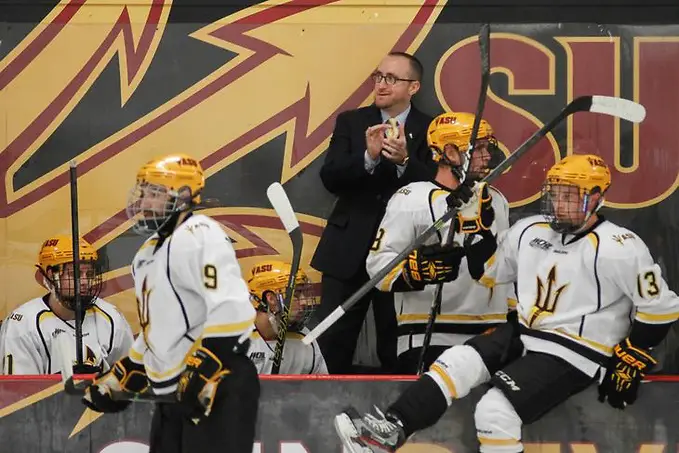
TEMPE, Ariz. — Thursday was a very positive day for Arizona State hockey.
While the school continues to officially take the stance that Thursday’s vote by the Arizona Board of Regents Business and Finance Committee would allow for the construction of a 5,000-seat multi-sport arena on the college’s campus, I’ve been around both college athletics and politics long enough to know and understand that the process going forward will hopefully be nothing more than a rubber stamp.
If that’s true, the university will receive somewhere in the neighborhood of $160 million dollars to renovate the existing Wells Fargo Arena and also construct the new facility in the parking lot next door that will be used for hockey, wrestling and gymnastics.
The full Board of Regents must vote to approve the project on Feb. 8, but the unanimous vote on Thursday by the committee that controls the purse strings is a step in the right direction.
So what will this mean for Arizona State? In essence, everything.
Though the Sun Devils have taken an extremely positive approach since the day they launched the program less than three years ago, playing home games at the Oceanside Ice Arena, a facility that can hold less than 1,000 spectators and lacks the infrastructure to operate at a high level, isn’t ideal.
Friday, when Arizona State faced Boston University at Gila River Arena, the home of the Arizona Coyotes, you saw the other end of the spectrum – a few thousand fans spatters around an oversized building. Moving that game to Gila River was a good move as a similar number of fans will try to cram into Oceanside on Saturday, but isn’t a long-term possibility either.
Thus the solution has been evident since day one – build a first-class facility on campus to house the team. That solution has taken a good amount of time to finally seem possible.
“I know how hard our administration has worked to come up with a solution,” said Arizona State coach Greg Powers. “I’ve never had a doubt in my mind that they’d come up with something. I still don’t have doubt.
“But we’ll play wherever they tell us to play. We’ll play on Tempe town lake if they tell us to play there.”
Being a state school, finding the way to fund the facility without using tax payer or tuition money has been a hurdle, one that took its first step to be crossed after Thursday’s over.
At times in the process, there was negotiation with the Coyotes to possibly build dual buildings. It is something that seems like it could have been a win-win for the two parties. The Coyotes desperately need to move closer to the Phoenix/Scottsdale/Tempe area. Currently playing about 25-30 miles west in Glendale, it is a traffic nightmare trying to get to the area from the Phoenix metro area on weeknights.
But the process for the two sides to meet hit an impasse. Reports said that ASU was willing to shutter its Karsten Golf Course to provide enough land in the area of its athletics campus to fit both the smaller building to house ASU and the larger building to house the Coyotes. Those negotiations feel through.
(As an aside, having played that golf course during the trip, I’m happy about this. The ASU Karsten course is a gem of a golf course.)
Now Arizona State seems poised to move ahead by itself, something that in the long term could pay dividends.
The 500-pound elephant that continues to hang over the heads of Arizona State is the fact the team is absent a conference. There has been plenty of talk of homes. The NCHC or WHCA seemed potential fits geographically, but both have said no for the moment. And you have to wonder how much the long-term plan, which has to include the arena, impacts those decisions.
You also hear rumors about the Big Ten, a conference with large-scale all-sports programs similar to Arizona State.
But finding a conference home is about the correct fit for not just the conference but the team.
You can look at Notre Dame as a perfect example. The Fighting Irish’s move to Hockey East seemed great at inception. But when you realize that every road game in the league means getting on a plane while your opponents are forced to make that trip just once every two years didn’t work for Notre Dame. In the Big Ten, the Irish find more bus trips and their league opposition spends as much time traveling by air as bus.
That is one of the reasons the Big Ten doesn’t seem like a great fit for the Sun Devils. While all of the schools would be like-minded Division I programs, the travel disparity might not create a perfect fit. Every road game would mean hoping on a plane. And sure, that’s nothing different than the current situation for Arizona State, but it would probably mean 50 percent more air travel than the other seven teams.
That leaves the WCHA and NCHC, two leagues where travel is difficult for every school involved. The WCHA moves teams from Alaska to Alabama. NCHC teams travel from Colorado to Ohio with a spattering of far north stops in between.
Technically, either would be a decent fit for the Sun Devils. The WCHA has experience in taking in an independent having given a home to Alabama-Huntsville. The NCHC hasn’t expanded from its original eight but all eight schools have athletic departments where hockey is a major focus. While hockey will never be king at ASU, it is a sport the department seems very committed to.
There is a long way to go for the Sun Devils and there certainly are no guarantees that any arena comes to fruition.
But the process is underway, the potential is eminent. And that’s something for not just Arizona State, but also college hockey, to celebrate.


